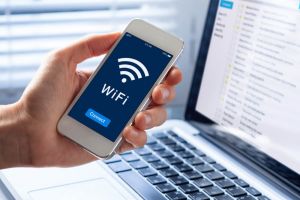Mobile phone plans are getting bigger and bigger every year – so big in fact that they could even start to replace traditional fixed line internet services in Australian homes. For many of us, our smartphone is our gateway to internet on the move, but once we return home we simply log back onto our Wi-Fi and save our mobile data for another day. This makes perfect sense of course, but what if you had a mobile phone plans packed with so much data that you no longer needed a standard home broadband service? Find out if it’s worth ditching your internet for a larger phone plan in this Canstar Blue guide.
Can you use mobile hotspot as home internet?
Using your mobile hotspot as home internet is really only viable if you don’t use too much data. Depending on your internet habits, it might be the right fit for you, or you might find yourself running out each month. Here is a brief breakdown of the most common ways to use the internet, and how much data each activity takes up.
- General web browsing generally uses around 150MB per hour.
- Watching YouTube videos uses around 260MB per hour on 480p quality.
- Listening to Spotify on the default audio quality uses around 40MB per hour.
- Social media can use upwards of 400MB per hour depending on the app, and what content you’re looking at (e.g. text-heavy sites such as Reddit compared to video-heavy sites such as Instagram).
Basically, if you tend to use basic internet functions like browsing the web or checking emails, your current plan might be enough to use as a home internet replacement. However, if you tend to stream videos and enjoy sitting down to movie marathons, you’re far better off upgrading or sticking with home internet bandwidth. Check out our mobile data guide to see how much you may be using, and how much data you might need.
How to use mobile hotspot as WiFi
There may be times when you need to use your mobile data as WiFi for a laptop, computer or even TV. Luckily, this is easy to do and only takes a few simple steps.
Use mobile hotspot for WiFi on an iPhone
Step one: Open Settings > Mobile> Personal Hotspot
Step two: Set up a password for your Hotspot by tapping on the WiFi Password tab and choosing a password. This is the password you will need to give to anyone tethering to your hotspot, and will help protect your data from being used without your knowledge.
Step three: By tapping ‘Allow Others to Join’, you can turn on your WiFi so it’s ready for sharing.
Step four: On a different device, you and others can search for your Hotspot by opening their WiFi options and searching for the name of your phone. Once you enter the password you are connected and can begin using the internet on whichever device you have tethered from.
Use mobile hotspot for WiFi on an Android
Step one: Open Settings > Connections> Mobile Hotspot & Tethering
Step two: Set up a password and, if need be, the name of your device so it’s easy for you and others to find. This is the password you will need to give to anyone tethering to your hotspot, and will help protect your data from being used without your knowledge.
Step three: To open your Hotspot capabilities, swipe down from the top of the screen and tap the Hotspot symbol
Step four: On a different device, you and others can search for your Hotspot by opening their WiFi options and searching for the name of your phone. Once you enter the password you are connected and can begin using the internet on whichever device you have tethered from.
Pros and cons of using mobile hotspot over WiFi

Like most things, there’s always going to be pros and cons for using your mobile data as a hotspot instead of using traditional home internet and WiFi. But what exactly are the pros and cons? Find out below.
Pros of using a mobile hotspot over home internet
Pros of using mobile hotspot over your home WiFi include:
- Budget: By choosing to use mobile data over home internet you are accessing a range of far lower priced options, allowing you to comparatively save significantly on your internet bill.
- Portable: You can take your mobile hotspot wherever you are, meaning you can have easy access to internet on the road, on the way to work and away on holiday.
- Adjustable: A mobile hotspot can be turned off and on to suit your usage needs. By only using the internet when you need it, you could be saving quite a bit of money and data.
- Flexible: A mobile hotspot allows you to connect to multiple devices and to many different types of devices, giving you the flexibility to share it amongst friends and throughout your house.
Cons of using a mobile hotspot internet
Cons of using mobile hotspot over your home WiFi include:
- Limits: Your provider may have hotspot tethering limits, reducing your ability to use your internet as you normally would.
- Speed caps: Hotspot data could suffer from speed caps, slowing down your speeds greatly and limiting how you can use the internet. You can find out whether your provider includes speed caps by researching their Critical Information Summary (CIS) page.
- Reduced battery life: As you are using more of the functions on your phone, your phone’s battery life may drain at a much faster rate compared to regular use.
- Security: Your connection isn’t guaranteed to be secure. Using a hotspot can leave you vulnerable to scammers and hackers if you haven’t set it up properly and included an effective password.
Mobile hotspot speeds
Data isn’t the only thing you have to think about when considering a change to mobile data over home internet. In fact, the speed of your mobile data should be top priority, as it will dictate how you are able to use the internet as well as how often.
On average, 4G mobile hotspot tethering will give you speeds of about 30-40MBps, although this jumps up considerably if you are using 5G, which can grant you up to 50MBps. Compare this to the speeds you get on the NBN Standard plan (also known as NBN 50), which will see you accessing up to 50MBps on average. However, you can easily access higher speeds by upgrading your NBN plan, whereas speed for mobile hotspots generally sits at 30MBps, meaning NBN does have a backup if you need something quicker. It is important to remember as well, that this speed is calculated before any speed caps, meaning if you surpass a general 30GB you’ll see your speed drop right down to 2MBps – not exactly ideal for everyday use.
As a result, a browsing speed of around 30-40MBps may be enough for one person to browse, stream, upload and download – or even suit a small household of modest internet usage – but it may not be the quickest, or best, option for households that are looking to do multiple things at once.
Mobile Phone Plans with Big Data Limits

There are nine providers that currently offer 100GB or more of mobile data, plus unlimited calls and texts for less than $80 a month. If you’re thinking about swapping out home internet for mobile data, these providers offer you a good amount of data for an affordable price. However, each provider will come with their own internet speeds and possible tethering limits, so it’s important to do your research before you commit.
Prepaid mobile phone plans with big data limits
Postpaid mobile phone plans with big data limits
Using unlimited data for home internet
If you’re looking to use your mobile data in place of home internet, it seems like a no brainer to opt for an unlimited data plan, but unfortunately the word ‘unlimited’ doesn’t always mean just that. Currently in Australia the three big telcos – Telstra, Optus and Vodafone – along with Felix and Belong are offering unlimited data plans, also advertised as ‘full speed data,’ ‘data at no extra cost’ and ‘endless’ data. While this all sounds like the perfect option for home browsing, plans with unlimited data often come with speed caps, meaning that once they hit a certain limit, the speed of the internet slows right down to 1.5MB per second in the case of Optus and Telstra, and 2Mbps for Vodafone. This can make it impossible to work from home, stream movies or even use the internet outside of browser searching. The only way to avoid the ‘unlimited data’ trap is to read the T&Cs of your phone provider carefully, keeping a keen eye out for mention of ‘speed caps’, or ‘full speed data.’
The following table shows selected published Optus SIM-only postpaid plans on Canstar Blue’s database, listed in order of cost, from the lowest to highest and then by data allowance, largest to smallest. Use our comparison tool to see plans from a range of other providers. This is a selection of products with links to a referral partner.
The following table shows selected published Telstra SIM-only postpaid plans on Canstar Blue’s database, listed in order of cost, from the lowest to highest and then by data allowance, largest to smallest. Use our comparison tool to see plans from a range of other providers. This is a selection of products with links to a referral partner.
The following table shows selected published Vodafone SIM-only postpaid plans on Canstar Blue’s database, listed in order of cost, from the lowest to highest and then by data allowance, largest to smallest. Use our comparison tool to see plans from a range of other providers. This is a selection of products with links to a referral partner.
Should you replace home internet with a mobile hotspot?
Replacing your home internet with a mobile hotspot can be a great strategy to save money and streamline your internet usage. However, depending on your provider, it can come with data and speed limitations, greatly affecting how and when you use your internet, meaning that while great in theory, it may not end up being practical, particularly if you use the internet a fair bit, or have multiple people in your house. The best way to decide if it’s the right choice for you is to look at how you currently use the internet and determine if your browsing habits will fall within your data limits. But if you’re still keen on changing, make sure you read the T&Cs of any ‘unlimited’ data plans you come across, and consider upgrading from your current plan to one with a more generous data inclusion.
Original Author: Luciana Lawe Davies

Share this article